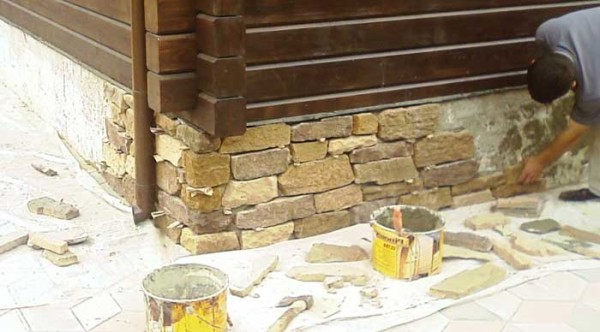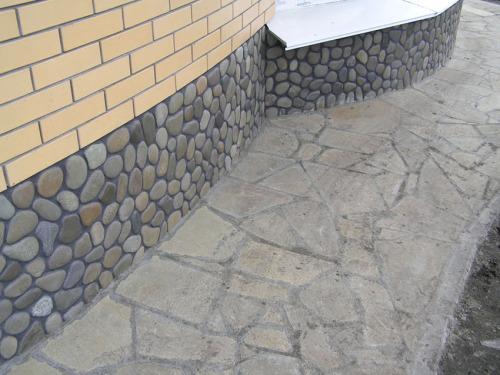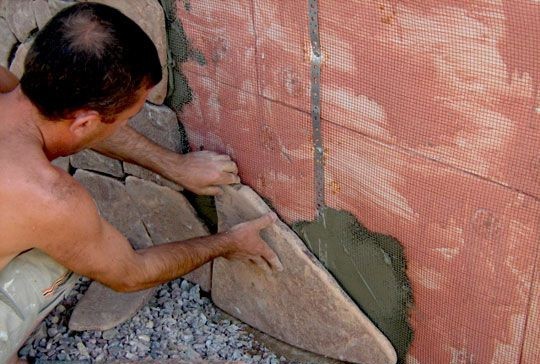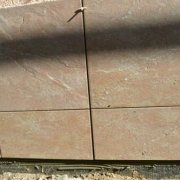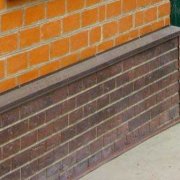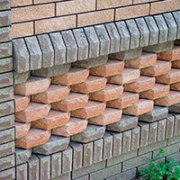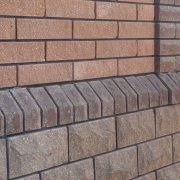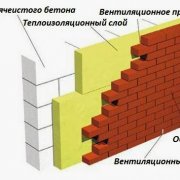Facing the foundation with stone and its features
The foundation, like the whole structure as a whole, needs finishing work for the original design. There are various materials for such purposes, but stone facing the foundation is currently in great demand.
The content of the article
What type of foundation can be stone faced
Only those bearing substrates that have a certain height above the ground surface are finished. They are called a base (seeFinishing the basement of the house: work options).
The function of such substrates is to protect against exposure to the floor in a cold climate.
What you need to provide:
Tip. It will be mandatory to warm such a structure using expanded clay or any other material, on top of which you can make a screed and level the floor surface inside the house.
- This foundation is built of red refractory brick, which does not have an attractive appearance and must be designed in accordance with the design of the entire structure.
Tip. Facing the foundation of stone is suitable for facing the building with any design.
Foundation design options using stone
The stone for facing the foundation of the house can be:
- Artificial.
- Natural.
Features and specifications:
- In appearance, these types of materials do not have significant differences, since the decorative facing stone for foundations on the surface can have an imitation of natural agglomerate.
- You can talk about the beauty and sophistication of natural stone for quite some time. There are various types of it that are used in finishing the foundation of the building and for performing other external finishing works.
Foundation cladding any of these materials will be quite original and unusual.
Varieties of natural agglomerates that are often used in decorating the foundation of a house
Facing stone for the foundation has several options that are most often used in the decoration of the foundation:
- Marble.
- Lemesitis.
- Granite.
- Dolomite.
- Sandstone.
- Shungite.
- Shell rock.
- Quartzite.
- Slate.
Material Details:
- Other varieties of natural agglomerates may be used. All of them have almost the same properties and have the same technical characteristics.
- The price for each of them is different. Marble is considered the most expensive, and sandstone is the most affordable.
Accordingly, the most durable and reliable is marble, and the most fragile is sandstone. - This is due to their structure, which is several times denser in marble than in all other natural agglomerates.
- Natural stone for facing the foundation has various sizes and shapes. It can be square or rectangular, round or oval.
It all depends on the manufacturer. There are straight plates. The thickness of the material can be 1 cm or reach 5 cm.
Tip. The thickness of natural stone, which reaches 5 cm or more, creates an additional load on the base of the structure and if the surface is prepared poorly for the installation of natural stone, then the whole design will begin to deform over time.
Advantages and main properties of natural agglomerate
Natural stone for facing the foundation has excellent properties and characteristics. Due to the density of the structure of such a material, the finish will be durable.
Characteristics:
- There are some species whose structure is porous, but their strength and reliability remain high. This type of natural stone has excellent heat capacity and is able to protect the foundation from the penetration of cold air masses.
- Natural material has one main advantage - it is environmentally friendly and does not harm human health.
Tip. When buying natural agglomerate, it is necessary to ask the seller for certification documents that confirm that the stone does not emit radiation.
Facing the foundations with natural stone:
- Moisture resistant, as the surface of such a material is not able to absorb moisture. It can simply change its shade for a while, but after complete drying, the design remains the original.
- Practical, since it does not require specific care for a surface that does not absorb dirt. For cleaning it will be enough to use dry rags without abrasive or other detergents.
- Long-lasting, no natural agglomerate operation lines are installed, as it can adapt to any climatic conditions.
- Durable and reliable. It is able to withstand quite significant loads, both mechanical and physical.
- Wear resistant. Throughout the entire period of operation, the external design of the surface of natural stone, as well as its structure, does not change.
- Frost-resistant, as it freely tolerates very low temperature conditions without deformation.
- Withstands fairly high temperatures, while the surface of natural stone does not heat up, and the density of the material structure also remains unchanged.
- It is worth noting that the stone does not burn and retains heat very well.
Tip. The natural agglomerate itself is quite cold, and in order to provide heat on the basement of the building, it will be obligatory to insulate it.
- For this, expanded clay, crushed stone, dry algae and other insulating materials are used, which, after installation, are poured with concrete mortar.
Do-it-yourself installation of natural stone is very quick and easy. Only the foundation surface is preliminarily prepared with high quality.
Preparation of the foundation surface for facing it with natural stone
Facing the foundation with natural stone requires proper surface preparation, which may be brick or concrete. The preparation methods for this do not change.
Tip. All work on preparing the foundation of the building for decoration is carried out efficiently, as it helps to get rid of moisture indoors and is fundamental to any home.
What you need to consider:
The temperature condition of the room and the percentage of air humidity depend on how the foundation is built and how the decoration is done.
What can threaten improper insulation and lining with a natural foundation stone after it:
- Humidity will be high. This will cause moisture to form on the surface of the walls or ceiling.
As a result - the formation of mold, which is quite difficult to deal with.
Where to start:
- Initially, a trench is dug around the entire perimeter of the structure, which reaches 20-30 cm in depth and 50-60 cm in width. This choice depends on the number of storeys of the house.
- After it is dug, gravel is poured into it, which by its properties is capable of quickly and simply diverting water from the foundation.
Tip. To increase the strength of the entire structure, it is connected to the main foundation with a reinforcing mesh.
- You can also use fiberglass mesh or made from another metal.
- An analysis of its condition is carried out on the very surface of the foundation. If there are any defects or irregularities, but all of them must be eliminated.
It is also worth filling with plaster or concrete mortar all the visible holes. - Also, after such work, it is worth priming the surface itself with a special tool that repels moisture. All solutions of this type are usually applied to the surface with a simple brush or roller.
To apply them correctly there is a special instruction, according to which all actions are performed.
Due to the properties of these products, water that falls under the finishing material is not absorbed on the surface of the foundation, but simply drains and leaves no traces.
Mounting natural stone on the foundation surface
Facing the foundations with natural stone is not too complicated. It all depends on what size and weight the material itself has.
The thickness of the tile also plays a large role. The ease of installation directly depends on this.
Work is performed using:
- Adhesive or concrete mortar. The concrete solution is made independently and for large tiles it must have high strength after drying.
Very often various fixatives and agents are added to it that increase the rate of solidification of the solution. - Spatula or trowel. This choice of tool depends on who and what is more convenient to work with.
- Containers for mixing concrete or giving a certain consistency to glue.
- A building level that helps to do the finishing work even on the surface.
- Plicoreza, it is only necessary to use special nozzles on equipment that are designed specifically for such work.
- Tape measures and pencil.
Tip. In order for the foundation lining with natural stone to be original, it is necessary to mount the stone in a chaotic manner. Especially if it is of different sizes and shapes.
Stages of work:
- After preparatory work, the surface should stand a little to dry completely after priming. Only then, using the level, determines the optimal finish.
- Each tile is placed on the surface and pressed tightly against it. Only the solution itself is applied to the back side of the natural agglomerate, and not to the surface itself.
Tip. There is a misconception where a large amount of concrete or glue solution contributes to a more solid fixation of natural stone on the surface.
This is not true. Do not apply the solution on the foundation and on the back of the material.
- All this is due to the fact that the finish will be very difficult and will simply fall off with the solution over time.
- Joints of the material can be treated with decorative putty. You can also use for such purposes a solution of concrete, to which a special coloring pigment is added in the manufacture.
To avoid questions, you can watch the video. It shows an example of the installation of natural sinter on a foundation.
